dionb wrote on 2025-02-18, 13:27:
[..] going down the BNC route instead. You do need a bit more - not just the transceiver itself but also two 50Ohm terminators, two T-pieces to connect to your card and the transceiver - and a run of RG58 cable. Sounds more complicated, but the huge advantage is that it sticks no further out from the back of your case than the height of that T-piece and everything clicks solidly in place with BNC connectors.
That's an interesting topic! 😃
Speaking of terminators, there are two types.
a) normal one with the cap
b) the other one with the ground wire.
If we use same type (a) only, there will be noise on the medium.
That's one of the reason people had issues with Cheapernet so often; inadequate termination.
The one with the ground wire has to be installed at one outer end of the bus (the long cable).
Here are some links I've found useful:
http://www.tiplord.com/networking/thin.htm
http://d.pcnews.at/ins/pcn/095/001800/main.htm
Irrelevant, but fun to read:
https://en.wikipedia.org/wiki/EAD_socket
Tip: TNC connectors are an alternative to BNC connectors.
They look some but won't rotate. In my CB radio hobby, coaxial cables with TNC connectors turned out to be more reliable. They had less contact issues.
Might be worth a try. Good 50 Ohm RG58CU cables should work in either application (radio, network).
But H155 and other modern 50 Ohms coaxial cables with better specs might work as well.
Shops that sell ham radio stuff sould have them.
PS: There's something that comes to mind. It's perhaps superflous, but I think I should tell.
Very cheap coaxial cables consist of merely a very thin centre wire.
They're not very good, at least in the radio hobby.
They have reflections on the medium and cause a bad VSWR (reflected energy).
In the radio hobby, that's bad because the radio's transmitter will heat up unnecessarily.
To test such cables for reflections, radio amateurs or CB operators can use a network analyser like the NanoVNA or an old RigExpert AA-170.
The NanoVNA is very cheap and can be bought from various sources.
On the other side of the coaxial cable that is beeing tested a terminator has to be attached.
Aka an 50 ohm "dummy load", in radio jargon. An ethernet terminator will do just as well here for measuring.
Edit: Here are some tests/pictures..
Both cables aren’t being ideal by any means.
Ideally, the black cable should show a straight yellow line at the bottom.
Maybe the connectors have some corrosion or humidity ruined the cable, not sure.
But an standing wave (VSWR) with infinity on the beginning is definitely bad (red cable). It's like a short in RF application.
The reflections as shown would be a catastrophe on a LAN.
If such cables made it into circulation, it's no wonder that 10Base2 got such a bad reputation.
Disclaimer: There might be measuring errors.
NanoVNA uses harmonics for measuring higher frequencies.
If I had chosen a smaller range, maybe the results would have been more accurate.
This is just meant as a demonstration.
"Time, it seems, doesn't flow. For some it's fast, for some it's slow.
In what to one race is no time at all, another race can rise and fall..." - The Minstrel
//My video channel//


